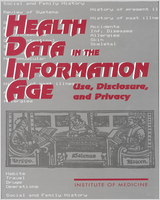NCBI Bookshelf. A service of the National Library of Medicine, National Institutes of Health.
Institute of Medicine (US) Committee on Regional Health Data Networks; Donaldson MS, Lohr KN, editors. Health Data in the Information Age: Use, Disclosure, and Privacy. Washington (DC): National Academies Press (US); 1994.

Health Data in the Information Age: Use, Disclosure, and Privacy.
Show detailsFrom the very first meetings, in the early 1970s, of the newly constituted Institute of Medicine (IOM) of the National Academy of Sciences, a major objective has been the engagement of the most important and difficult health and science policy issues from the public's or society's perspective. The Institute was created so that a broad-based and multidisciplinary membership could work across professions, within and without the health sciences, toward the solution of these complex and difficult problems.
From my personal experience as a staff member at the IOM during the first four years of its life, I can attest to the early recognition of the importance of the process of having a balanced, multidisciplinary committee working on the policy issues at hand. The assumption was that the sum of the parts of such a diverse group was surpassed by the synergy of the whole; more often than not, this positive learning experience also produced a useful document or report. In my personal experience with such groups, I cannot recall a failure either in the product and its value or in the process and its impact on the individuals participating. I must say, however, that the challenges facing this committee on regional databases were so great and our initial difficulties so intense in becoming clear about and comfortable with the seminal questions embedded in our charge that I was not optimistic about either our two-year experience together or the product that I could envision emerging.
Our challenges were formidable because the very nature of the "regional databases" was obscure to some, their potentials for good or harm were obscure to others, and the interweaving of such heavy strands of legal material with information technology, data management, security maintenance, and the substance of health services research made it exceedingly hard for many of us to get comfortable with our view and understanding of the completed policy tapestry.
But we did it! Never have I been on a committee with the dogged determination of this one; our relatively large committee seldom had a meeting wherein even one, let alone more than one, member was absent, and they stayed to the end. Never have I been on a committee wherein the doctors, scientists, data experts, lawyers, representatives of the public interest, and experts from the business world had such great expertise, such strong opinions, and such diverse perspectives.
The key to the success of this project, it seems to me, was the gradual emergence of a commonality in shared values. Somewhat to our collective surprise, we found ourselves unanimous in our acceptance of the following fundamental assumptions: (1) use of population-wide databases developed from individually collected, computerized personal health data has become a working reality; (2) potential benefits of such data sets used for financial, organizational, quality improvement, and research purposes to society are indeed great; (3) protection of the individual record from person-identifiable exposure must involve all possible behavioral, systematic, and technical security measures; (4) relevant data sets and analyses including hospital-, clinic-, and provider-specific data must be expeditiously made available to the public; and (5) bona fide researchers must have access to person-identifiable records in order to provide society with timely studies on health status and health care.
These five foundational elements were essential to the committee's collective thinking and its observations, conclusions, and recommendations as detailed in the report.
Once the committee came together around these ideas, it was able to move systematically through the myriad of policy implications that come from reasoning from basic principles. This could not have been accomplished without the indomitable persistence and prodigious intellectual work of Molla Donaldson and Kathleen Lohr. Karl Yordy made key contributions intermittently as was appropriate for an IOM division head.
Finally, it has become increasingly obvious to me (and I believe to the rest of the committee) that the future we see emerging before us, as a result of our participation in this study, has heavy implications for public education. In a way, developing an informed and sophisticated public is what regional databases and their analyses and reports are all about. The burden of these education efforts may fall primarily upon health database organizations, but in my view this responsibility belongs to all interested parties, institutions, and professions. The purpose of these new information technologies is to enhance the health status of society and to improve health care for the individual patient. We hope and trust that this report itself will contribute to public understanding of these complex but important matters.
ROGER J. BULGER, M.D., F.A.C.P.
Chair
- Preface - Health Data in the Information AgePreface - Health Data in the Information Age
Your browsing activity is empty.
Activity recording is turned off.
See more...